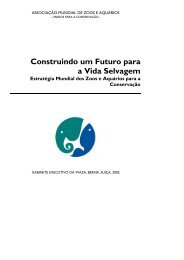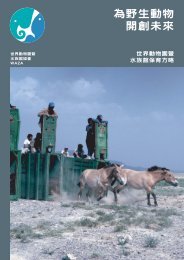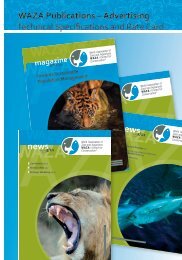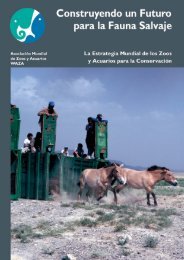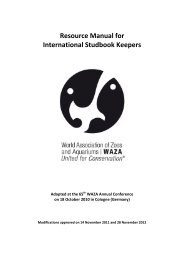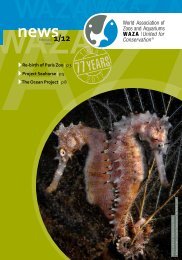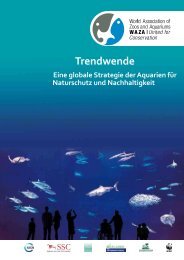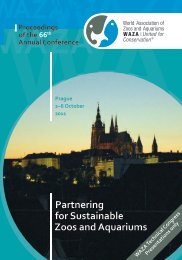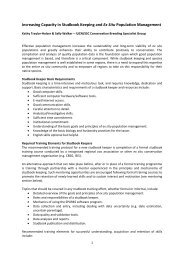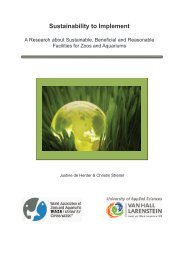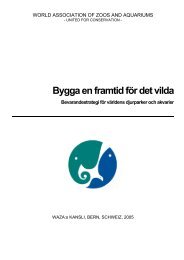Towards Sustainable Population Management - Waza
Towards Sustainable Population Management - Waza
Towards Sustainable Population Management - Waza
You also want an ePaper? Increase the reach of your titles
YUMPU automatically turns print PDFs into web optimized ePapers that Google loves.
WAZA magazine Vol 12/2011<br />
With clear goals defined by holistic<br />
species management plans, ex situ<br />
programmes will need to be refined<br />
and restructured to maximise success.<br />
The traditional approach of<br />
trying to sustain zoo populations only<br />
through breeding within exhibition<br />
programmes will be sufficient for<br />
only a relatively small number of<br />
species – those that are so popular<br />
that large exhibit populations will<br />
be maintained, that breed readily in<br />
exhibit facilities with little need for<br />
specialised facilities and that are easy<br />
to transport and amenable to periodic<br />
rearrangement of social groups. For<br />
the remaining species, a broader<br />
range of population management<br />
strategies needs to be considered<br />
along a management continuum<br />
(Conway 2011). For some species, this<br />
may mean Global Species <strong>Management</strong><br />
Plans (GSMPs) administered<br />
by WAZA. For others, it may mean<br />
placing breeding individuals into<br />
specialised breeding facilities, while<br />
ensuring that exhibit needs can be<br />
met with non-breeding animals. For<br />
yet others, it may mean exploring<br />
the concept of extractive reserves,<br />
a strategy that the aquarium community<br />
has already made progress in<br />
developing.<br />
Accomplishing the above will require<br />
additional resources and has implications<br />
for how ex situ institutions structure<br />
their financial plans. We will need<br />
to better understand our business<br />
models, questioning assumptions<br />
about what we believe may negatively<br />
impact our ability to manage<br />
species effectively. For example, zoos<br />
often assume that the public wants to<br />
see a huge variety of species and that<br />
if species collections are similar from<br />
zoo to zoo, then attendance will suffer.<br />
We assume that exhibits need to<br />
be large and elaborate to be successful.<br />
These assumptions need to be<br />
tested, as they impact our ability to<br />
develop business plans that expand<br />
our ability to adequately resource<br />
intensive population management in<br />
support of conservation goals.<br />
There are a number of factors that<br />
have contributed to a lack of success<br />
for many IMPs. Common problems<br />
include lack of necessary husbandry<br />
expertise, regulatory obstacles, space<br />
limitations, inadequate founder base<br />
and lack of institutional commitment,<br />
exacerbated by poor communication<br />
among staff and lack of<br />
accountability for those responsible<br />
for implementation of recommendations.<br />
None of these obstacles is insurmountable,<br />
but overcoming them<br />
will require commitment to change.<br />
Discussion among IMP workshop participants<br />
led to the identification of<br />
specific actions needed in areas from<br />
species prioritisation to collection<br />
planning, exploration of new management<br />
approaches and integration<br />
with other conservation efforts and<br />
partners. Putting these recommendations<br />
into action to achieve success<br />
will require concerted efforts by zoo<br />
associations, zoos and individuals. Efforts<br />
are already underway to implement<br />
some of the necessary activities<br />
identified at the IMP workshop. The<br />
scope and urgency of the species conservation<br />
crisis obligates us to move<br />
ahead as quickly as possible.<br />
Intensively Managed <strong>Population</strong>s 43<br />
References<br />
• Baker, A. (2007) Animal ambassadors:<br />
an analysis of the effectiveness<br />
and conservation impact of<br />
ex situ breeding efforts. In: Zoos<br />
in the 21st Century: Catalysts for<br />
Conservation? (ed. by Zimmermann,<br />
A., Hatchwell, M., Dickie,<br />
L. A. & West, C.), pp. 139–154.<br />
Cambridge: Cambridge University<br />
Press.<br />
• Conde, D. A., Flesness, N., Colchero,<br />
F., Jones, O. R. & Scheuerlein,<br />
A. (2011) An emerging role<br />
of zoos to conserve biodiversity.<br />
Science 331: 1390–1391.<br />
• Conway, W. G. (2011) Buying<br />
time for wild animals with zoos.<br />
Zoo Biology 30: 1–8.<br />
• Cook, R. A. (2010) Defining what<br />
it means to save a species – the<br />
species conservation program of<br />
the Wildlife Conservation Society.<br />
In: Proceedings of the 65th WAZA<br />
Annual Conference (ed. by Dick,<br />
G.), pp. 30–31. Gland: WAZA.<br />
• Gusset, M. & Dick, G. (2011)<br />
The global reach of zoos and<br />
aquariums in visitor numbers and<br />
conservation expenditures. Zoo<br />
Biology 30: in press.<br />
• Lees, C. M. & Wilcken, J. (2009)<br />
Sustaining the Ark: the challenges<br />
faced by zoos in maintaining<br />
viable populations. International<br />
Zoo Yearbook 43: 6–18.<br />
• WAZA (2005) Building a Future<br />
for Wildlife: The World Zoo and<br />
Aquarium Conservation Strategy.<br />
Berne: WAZA.



